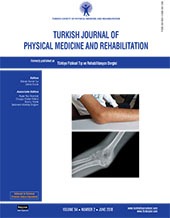Does the lower extremity alignment affect the risk of falling?
Patients and methods: Between April 2016 and December 2016, a total of 74 individuals (24 males, 50 females; mean age 32.2±4.9 years; range 18 to 65 years) were included in the study. The knee Q angle and Chippaux-Smirak Index (CSI), Arch Index, and foot progression angle (FPA) evaluated by pedobarography were used for the assessment of the lower extremity alignment. The fall risk was evaluated by the Fall Index, Fourier 56 Index (F56), and Stability Index.
Results: The fall index was found to be correlated with the Q angle, CSI, the Arch index, and FPA (p<0.05). Q angle, Arch Index, and FPA which were explained 40% of the variance of the fall index. The Q angle was correlated with F56 and the stability index at the most position (p<0.05). The CSI was correlated with the F56 and the stability index at two and three positions, respectively (p<0.05); however, the Arch Index and FPA were not correlated with the F56 and Stability Index at any of the eight positions (p>0.05). According to the categorical regression analysis, the Q angle was the most effective on the F56 and Stability Index.
Conclusion: Our study results suggest that lower extremity malalignment increases the risk of falling. We believe that the risk of falling can be decreased by the reduction of these malalingments and, thus, mortality and morbidity associated with the fall can be reduced as well.
Keywords : Arch Index; Chippaux-Smirak Index; falling; foot progression angle; pedobarography; Q angle

















